
Semper Fi
~ Always Faithful ~
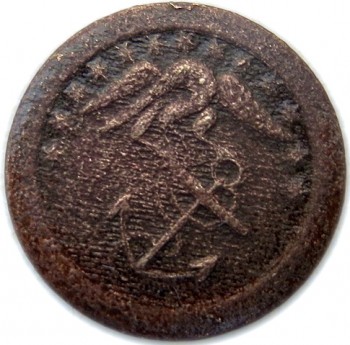
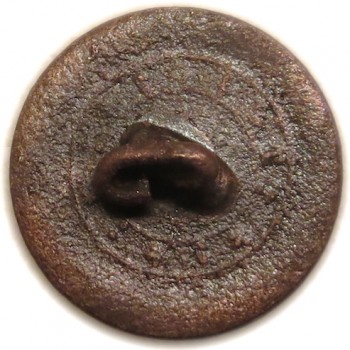
1820’s United States Marines
Color: An Ochre of Brown & Shades of Red.
Metal: Flat, 1-Piece, Raised Design, Gilt Brass.
Size: 20.69mm. Coat Size
Albert’s Number: MC 2: RV 35
Tice’s Number: MC 106
Variation: Flying Spread-Wing Eagle Facing Down / Large Slanted Fouled Anchor / 13 Six-Pointed Stars / Irregularly Lined Field.
Present Condition: An Excavated Specimen, Good Planchet Condition, Good High Relief Pattern Remains.
Robert’s Notes: This button was most likely made by Robinson during the 1820’s. During the Revolution, Congress authorized the enlistment of the Marines to serve as Naval Infantry men. There primary duty was to keep order aboard American Ships, and to act as guards at Naval shore installations. The button’s pattern depicts a Flying Spread-Wing Eagle Facing Down with the anchor’s rope in it’s beak. Underneath is a Large Slanted Fouled Anchor. In the eagle’s left talon is the anchor’s top ring. The slack rope comes off the anchor’s top ring on the left hand-side and goes over and under the stock, and then through the eagle’s beak, and then under and over the shaft 3x, then over the right fluke ending under the crown. In the top legend, there are 13 Six-Pointed Stars arced above the eagle. The high relief pattern is set on a Irregularly Lined Field, with a wide plain raised round edge. These early Marine buttons are usually very hard to come by, because the Marine Corps didn’t have many men. Tice even noted that by 1851, the Corps only consisted of 1800 officers and men.
Reverse Button Analysis: This is a one-piece button with a soldered on wedge shank. The shank is original, and intact, but twisted and broken open. GILT *.*.*.*. rm
The RJ. Silverstein Collection.~
Dug in Fernandina Florida by J.B. near Fort Clinch.
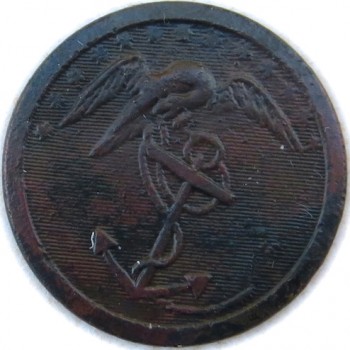
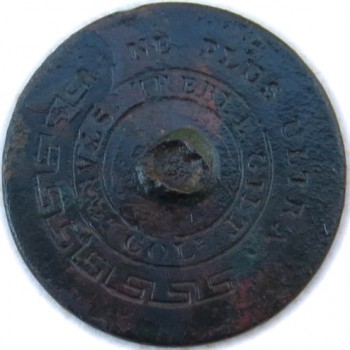
1820’s United States Marines
Color: A Red Clay Brown.
Metal: Flat, 1-Piece, Raised Design, Gilt Brass.
Size: 22.89 mm. Coat Size
Albert’s Number: MC 3-B: RV 35
Tice’s Number: MC 112
Variation: Flying Spread-Wing Eagle Facing Down / Large Slanted Fouled Anchor / 13 Six-Pointed Stars / Lined Field.
Present Condition: An Excavated Specimen, Good Planchet Condition, Strong High Relief Pattern Remains.
Robert’s Notes: This button was most likely made by Robinson during the 1820’s. During the Revolution, Congress authorized the enlistment of the Marines to serve as Naval Infantry men. There primary duty was to keep order aboard American Ships, and to act as guards at Naval shore installations. The button’s pattern depicts a Flying Spread-Wing Eagle Facing Down with the anchor’s rope in it’s beak. Underneath is a Large Slanted Fouled Anchor. In the eagle’s left talon is the anchor’s top ring. The slack rope comes off the anchor’s top ring on the left hand-side and goes over and under the stock, and then through the eagle’s beak, and then under and over the shaft 3x, then over the right fluke ending under the crown. In the top legend, there are 13 Six-Pointed Stars arced above the eagle. The high relief pattern is set on a Lined Field, with a wide plain raised round edge. These early Marine buttons are usually very hard to come by, because the Marine Corps didn’t have many men. Tice even noted that by 1851, the Corps only consisted of 1800 officers and men.
Reverse Button Analysis: This is a one-piece button with a soldered on wedge shank. The shank is original, straight, and intact. . NE PLUS ULTRA. Decorative pattern / TREBLE GILT/ STRAND d COL x
The RJ. Silverstein Collection.~
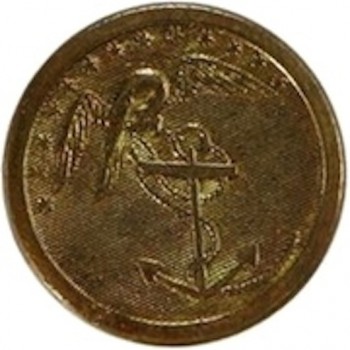
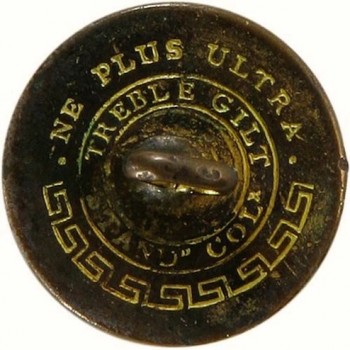
1820’s United States Marines
Color: A Golden Brown.
Metal: Flat, 1-Piece, Raised Design, Gilt Brass.
Size: 23 mm. Coat Size
Albert’s Number: MC 3-B: RV 35
Tice’s Number: MC 112
Variation: Flying Spread-Wing Eagle Facing Down / Large Slanted Fouled Anchor / 13 Six-Pointed Stars / Lined Field.
Present Condition: A Non Excavated Example, Excellent Planchet Condition, Excellent High Relief Pattern Remains.
Robert’s Notes: This button was most likely made by Robinson during the 1820’s. During the Revolution, Congress authorized the enlistment of the Marines to serve as Naval Infantry men. There primary duty was to keep order aboard American Ships, and to act as guards at Naval shore installations. The button’s pattern depicts a Flying Spread-Wing Eagle Facing Down with the anchor’s rope in it’s beak. Underneath is a Large Slanted Fouled Anchor. In the eagle’s left talon is the anchor’s top ring. The slack rope comes off the anchor’s top ring on the left hand-side and goes over and under the stock, and then through the eagle’s beak, and then under and over the shaft 3x, then over the right fluke ending under the crown. In the top legend, there are 13 Six-Pointed Stars arced above the eagle. The high relief pattern is set on a Lined Field, with a wide plain raised round edge. These early Marine buttons are usually very hard to come by, because the Marine Corps didn’t have many men. Tice even noted that by 1851, the Corps only consisted of 1800 officers and men.
Reverse Button Analysis: This is a one-piece button with a soldered on wedge shank. The shank is original, straight, and intact. . NE PLUS ULTRA. Decorative pattern / TREBLE GILT/ STRAND d COL x

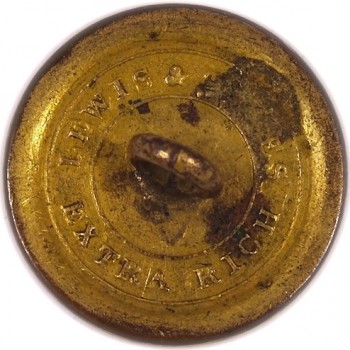
1820’s-30’s United States Marines
Color: A Golden Brown.
Metal: Flat, 1-Piece, Raised Design, Gilt Brass.
Size: 23 mm. Coat Size
Albert’s Number: MC 4-B: RV 50
Tice’s Number: Unlisted Variant & Back Mark
Variation: Flying Spread-Wing Eagle Facing Down / Large Slanted Fouled Anchor / 15 Six-Pointed Stars / Lined Field.
Present Condition: An Excavated Example, Good Planchet Casting, Good High Relief Pattern.
Robert’s Notes: This button was made by Lewis & Tomes for a brief time during the late 1820’s. The button’s pattern depicts a Flying Spread-Wing Eagle Facing Down with the anchor’s rope in it’s beak. Underneath is a Large Slanted Fouled Anchor with a Semi-Arrow Pointed Thick Shaped Stock. In the eagle’s left talon is the anchor’s top ring. The slack rope comes off the anchor’s top ring on the left hand-side and goes over and under the stock on the right-hand side, and then through the eagle’s beak, and then under and over the shaft 3x. Then the rope goes under the left fluke and waving off the left hand side. In the top legend, there are 15 Six-Pointed Stars arced above the eagle. The high relief pattern is set on an Evenly Lined Field, with a wide plain raised round edge picture frame border. These early Marine buttons are usually very hard to come by, because the Marine Corps didn’t have many men. Tice even noted that by 1851, the Corps only consisted of 1800 officers and men.
Reverse Button Analysis: This is a one-piece button with a soldered on loop shank. The shank is original, straight, and intact. RM Lewis & Tomes/Extra Rich with in two concentric raised rings.

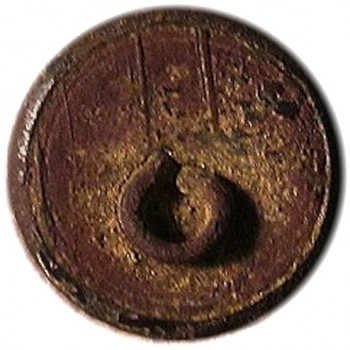
1861-65 United States Marines
Color: A Desert Clay Brown.
Metal: Convex, 2-Piece, Raised Design, Gilt Brass.
Size: 23 mm. Coat Size
Albert’s Number: CS 76: RV 300
Tice’s Number: CSM 200
Variation: Stippled Roman High Relief Letter, “M”
Present Condition: An Excavated Example, Strong Planchet Casting, Strong High Relief Pattern.
Robert’s Notes: On March 16, 1861, the Confederate States envoked an official Act to Provide for the Organization of the Navy, and instituted the establishment of a Corps of Marines. Unfortunately, the official uniform and dress code doesn’t prescribe any buttons for the corps of Marines. Several old collections do have buttons labeled, “Marines” which indicates buttons were made for this organization specifically. H T & B Manchester back mark buttons supplied by the British to the Confederate Army strongly point toward Marine issue. There was also some evidence supplied by the Atlanta Historical Museum there was another manufactured button by Horstman and Alien NY. They had an original uniform which was owned by a Second Lieutenant Henry Graves. Research indicates he was in command of 20 Marines that served on the CSS Savannah. The button’s pattern depicts a Stippled “M” using Roman font. The high relief letter “M” is set on a plain convex field with a raised border edge. This button was the only one made for the Confederate Marines. Collectors find this one of the most desirable buttons to obtain.
Reverse Button Analysis: This is a 2-Piece button with a loop shank. The shank is original, and intact, but crushed flat.
Dug at Dutch Gap, Virginia.